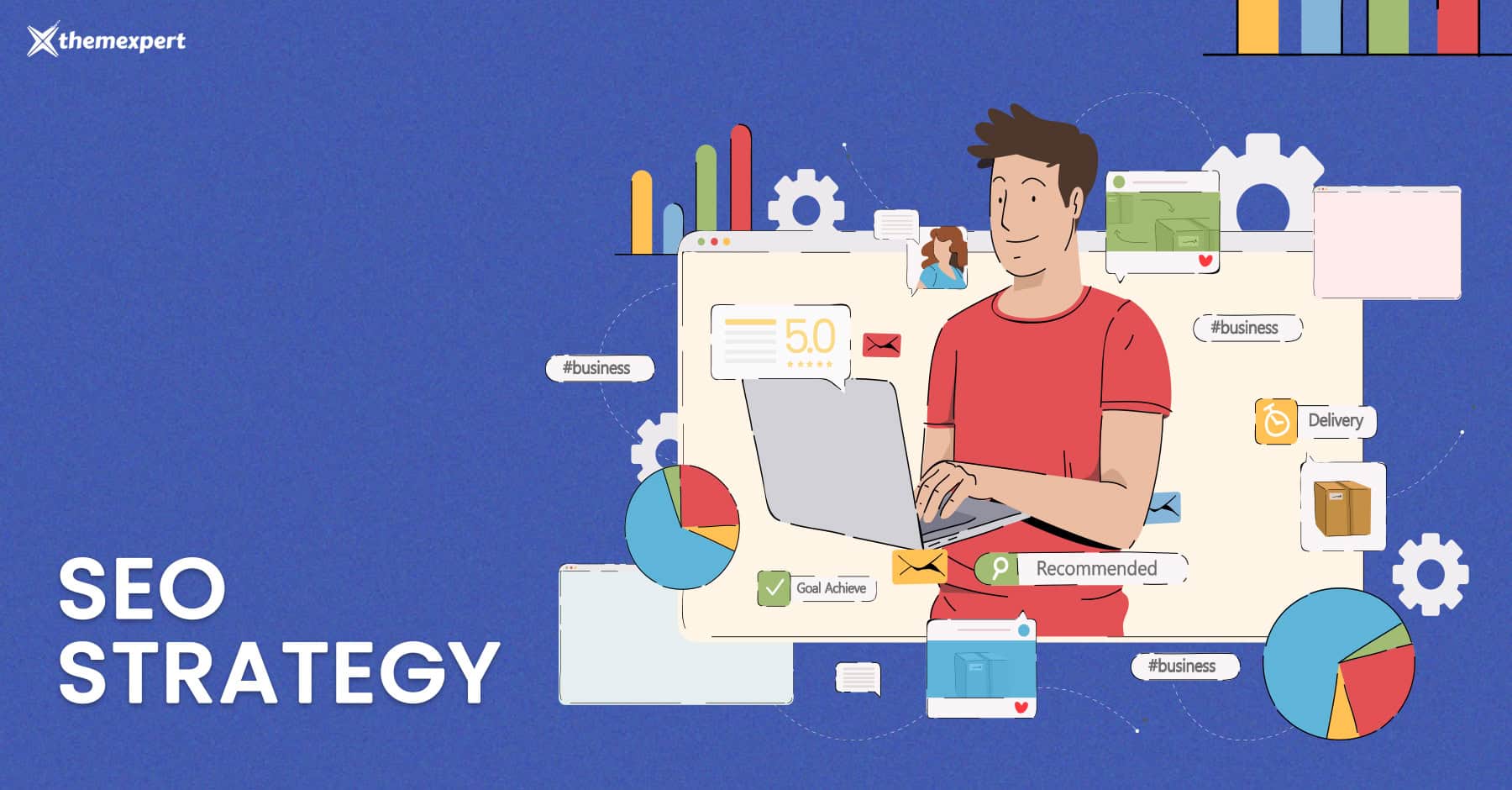When we talk about search engine optimization, we usually just talk about pleasing Google. But if you do it right, you can use an SEO strategy to better serve your customers as well as the algorithm. With 53% of traffic being won from SEO, a lot of your customers are interacting with you via search.
When we talk about search engine optimization, we usually just talk about pleasing Google. But if you do it right, you can use an SEO strategy to better serve your customers as well as the algorithm. With 53% of traffic being won from SEO, a lot of your customers are interacting with you via search.
Whether you’re selling shoes or PBX business phone systems, an SEO strategy is essential for getting in front of your customers. Without some basic search engine optimization strategy, your customers will never find the solutions they’re looking for. But if you go even further with SEO, it can start to benefit other aspects of your products and business.
Read more: The first SEO steps after you’ve set up a new website in 2022
With that in mind, let’s go over some best practices for SEO that can also improve your customer experience.
Create high-quality content
Great content is part of any good search engine optimization strategy. And if it really is good, it’s also valuable information to customers trying to make a purchase decision. By tailoring your content to the search queries your customers are making, you’ll improve your SEO rankings. And, in turn, you’ll deliver great experiences to your customers.
This starts with a keyword strategy. A keyword strategy is a process of finding out what your customers are searching for and deciding which search terms to target.
Since SEO is such a winner-takes-all game, you want to target “long-tail” keywords without too much competition. This means thinking about pieces of content that are as niche and specific to your ideal customer as possible so that you’ll rank #1 when they ask their burning question.
If you’re selling a B2B solution like web conferencing tools, you have a powerful tool that can be used in a lot of contexts. This is great for your content strategy, as you can write a blog post or article targeting many different use-cases while covering some of the same selling points every time.
Beyond just writing how-to tutorials, you can also write about topics like presentation skills, virtually delivering a business proposal and how to structure conferences, using the expertise you’ve gathered during your time in the business.
The important thing is to understand what your ideal customer is searching for and offer the best, most relevant guidance on that. Your H1 and H2 headings should reflect searches like “How to advertise a web conference” or “Best ways to structure a web conference”.
In an age of diminishing attention spans, readers will bounce if you don’t hook them in fast. So you want to deliver as much value as soon as you can to keep your bounce rate low.
Recipe sites have become notorious for packing hundreds of words of fluff at the beginning before the recipe users are searching for. This was done to boost time on the page, which was good for SEO at the cost of the customer experience.
Google has since started pulling information like recipes out of the site page and putting it directly in the search results, serving those sites’ customers better than the sites themselves.
Some best practices for your content include keeping paragraphs short and using headings to make your work skimmable. In a long piece, you could include a table of contents at the beginning to take users directly to the answers they’re looking for.
As well as creating “user stories” and content for your ideal customers, you can tailor your content to different stages of the buyer journey.
Content for the “discovery” stage could introduce your product to different users and talk about:
- Unique selling points
- Features
- Relevant case studies
“Consideration”-level content could compare your product to competitors, use industry reports and whitepapers to position yourself within your market, and demonstrate authority and expertise.
At the “decision” stage, you should focus on topics like pricing, promotions, reviews, etc. If people are reading your “decision” content, you should assume they’re very high intent and ready to buy.
This should include clear CTAs and invitations to book a trial or schedule a sales call. Once they’ve made the purchase, you can continue to create valuable content by focusing on topics like FAQs and “how-to” guides.

Monitor site speed
If your site doesn’t load within a couple of seconds, many users will just leave. The fact that your site should be fast and responsive should be obvious. However, bloated sites are an increasing problem, especially in image-rich eCommerce sites.
A slow, jumpy site is a bad customer experience, and it’s bad for SEO. Google also makes the PageSpeed tool that helps you analyze your site’s load time, and they use the same technology to rank sites based on how responsive they are. This makes it an underrated free SEO tool for you to take advantage of.
Speed is essential to a good user experience, and that’s another factor in your customer experience and search engine ranking. If your site’s user experience is good, you’ll see visitors staying longer to browse your site. The extra engagement plus internal links clicked will boost your search ranking, as well as serve as an indicator of good UX.
Focus on mobile
Another essential for your site is a good mobile experience. Part of a search engine optimization strategy is finding out how, when, and where users are accessing your site. If your users are primarily on mobile, you need to be optimizing your site and your SEO efforts toward mobile users.
A mobile visitor probably isn’t a B2B user carefully researching your product. Depending on your product, they might be a high-intent repeat buyer just topping up their supply, or maybe they’ve just seen you on social media, and they’ve come for a quick browse.
Either way, your mobile site’s landing pages should have clear, actionable CTA buttons that take them where they want to go. You should also make special considerations for mobile site speed. On a smaller screen, for example, you can afford to compress images a lot more if it means loading the image quickly.

Be social
With almost all of your customers on social media, you need to be meeting them where they’re spending their time. It’s a place where users are able to ask questions and leave feedback, but you can also make it part of your search engine optimization strategy.
By using relevant keywords as hashtags on your posts, you can get your posts to take up SERP rankings while also getting the word out on social media. You can increase the SERP ranking on your posts by driving engagement, and you can drive engagement by interacting with customers on the site.
This means responding to customer comments, whether positive or negative and creating content that’s likely to get likes and comments.
By creating valuable content for social media, you can create a great top-of-funnel customer experience while benefiting your SEO strategy for free. And by spreading your blogs and article content on social media, you can build backlinks to those pages if your social audience decides to share them in their own posts.
Check your site architecture
Optimizing your site’s architecture can benefit both your search engine optimization as well as your customer experience. Google’s web crawlers inspect your site for factors like internal links from one page of your site to another.
Over time, internal links will boost the ranking of the linked page because visitors are clicking through to spend time there. This is good for customers because you should be linking to pages that will provide more value to the visitor than one post possibly could.
By strategically linking your “focus” or “funnel” content - a priority for SEO - you can create customer journeys that have a higher chance of leading to conversions.
Use reviews

Social proof is one of the most powerful tools you have to educate and reassure potential customers. You can also make it part of a solid search engine optimization strategy.
77% of customers say they feel better about a company that asks for feedback. And you probably know yourself that qualitative feedback from customers is some of the most valuable data you can collect.
So don’t be shy about including requests for reviews in your recurring emails. If you don’t get the feedback you’re asking for, consider entering reviewers in a prize draw if they provide positive or negative feedback.
By placing those reviews prominently on your site in a way that Google’s spiders can crawl, your reviews might appear in Google’s rich snippet for your site. If you have a five-star review function, this can appear in the search result below your page’s title or the Google Shopping thumbnail for your product.
As Google uses this to measure your site’s credibility, you’ll also see an increase in your domain’s SERP ranking as you gather more reviews. So it’s worth the effort to be proactive about asking for them.
Positive reviews are a great ad that potential customers can trust. And negative ones are useful feedback to integrate back into your product. Either way, you should recognize the effort that goes into each review and reply to each one courteously.
Build your knowledge base
A well-stocked knowledge base is a great asset for your SEO strategy. It’s the natural place to put FAQs, how-tos, and other relevant content that high-intent searchers will be looking for.
You can aim your knowledge base toward organic traffic with titles like “How to calculate pro-rata salary” or “How to record high-quality web conference audio.”
These could provide useful information aside from the buttons to press to do those things in your app. You could provide a manual way to solve these problems and then emphasize how they’re easier with your product.
For customers who’ve already bought from you, a good knowledge base is part of a great customer experience. Make sure the areas of your knowledge base are split into relevant categories and apply the usual SEO content principles. Make it simple, skimmable, and clear. If you need to make a point in detail, split that off into its own knowledge base page and link to it.
Go local
When we talk about search engine optimization strategy, we talk about global search volume and rankings. But SEO is just as important for local businesses as it is for eCommerce. In fact, by focusing on a local niche, these businesses are in a good place to win their long-tail keywords outright.
For any local business looking to reach a new audience, getting listed on Google is essential. By providing your name, address, phone number, and other contact info on your site, you make it legible to Google’s site crawlers.
By running a full SEO strategy on a local basis, winning target keywords like “specialty coffee London” or “local electrician Bristol”, you can make yourself #1 in your area. You’ll do this by creating the best customer experience you can and using SEO to focus your efforts on the right audiences.
If you’re a small franchise with a few branches, consider creating local pages for each one. This will enable you to repeat your SEO playbook across each location you enter, tailoring online content and site copy to each location along the way.
SEO and customer experience
In the past, there were plenty of ways to boost SEO with tricks like keyword-stuffing or packing keywords in alt-text. But as Google has changed its ranking system to prioritize things like user experience, SEO and customer experience increasingly go hand-in-hand.
And no matter what the search ranking algorithm may do in the future, the best SEO strategy in the long term will always be delivering value to your customers in a way that builds up your brand as the #1 player in your niche.
With good content, a powerful site, and strong social proof, you have a platform you can use to create great experiences for customers you know better than anyone else.
Author Bio:
Gerard D’Onofrio is the Country Manager for Dialpad Australia, an AI-equipped business communications solutions platform for better communications at work. Gerard is experienced in discovering world-class developments and turning them into effective business advancements, wherever he goes.

